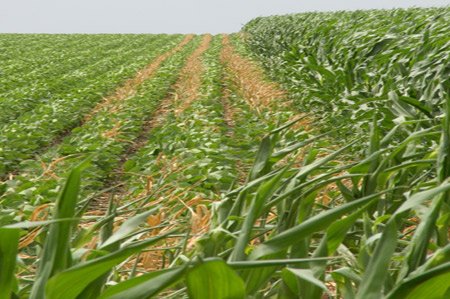 (AgWeb) – Jim Fitkin will plant against the grain this year. He’s planning to increase his corn acreage and slightly reduce his soybean plantings.
(AgWeb) – Jim Fitkin will plant against the grain this year. He’s planning to increase his corn acreage and slightly reduce his soybean plantings.
Yet Iowa farmers are likely to plant more than 10 million acres of soybeans for the first time since 2006, according to the latest U.S. Department of Agriculture projections. The agency anticipates record plantings across the U.S.
Soybean acres statewide are projected at 10.1 million acres, up 2 percent from last year, according to the report. Nationally, a record high 84.6 million acres are expected to be seeded, up 1 percent from last year.
“Corn acres will be down, no question,” said Fitkin, who grows corn and soybeans in rural Cedar Falls. “You’ve got so many acres, and when one goes up, the other goes down.”
The “other” this year is corn. But not on Fitkin’s land.
“I’ll be planting a little bit more corn and less beans, sticking with the rotation,” Fitkin said.
“I’ve always found if you do the opposite (of the trend), it’s better, anyway,” he said. “At this stage of the game, you’ve got people kind of guessing.”
Fitkin said his soybean acreage won’t be down dramatically — maybe 50 acres.
Iowa Agriculture Secretary Bill Northey said a switch to soybeans is hardly earth-shaking.
“Corn prices have softened a bit more than soybean prices, and certainly it’s cheaper to put soybeans in the ground than corn, but for the most part, most of our acreage won’t change much,” said Northey, who grows corn and soybeans near Spirit Lake. “I won’t plant additional beans because I put corn after soybeans, but there are some areas of the state that plant corn after corn some years. Some bring soybeans into their rotation quicker. My guess is we’ll still end up with acreage similar to previous years but slightly more acres of soybeans because of the market price.”
Most growers stick with their planned rotation schemes, Northey noted.
“Some of this routine starts almost before we get last year’s crop out,” he said. “We decide if we’re going to fertilize or do tillage based on what our long-term plan is.”
Leaders of the Ankeny-based Iowa Soybean Association just returned from a 10-day trade mission to China, the world’s largest consumer of soybeans, and reported China’s economy is projected to grow by about 7 percent.
That could bode well for soybean demand for years to come, Grant Kimberley, ISA market development director, said in a news release.
“Potentially, this will help utilize production from extra acres,” he said.
ISA President Tom Oswald said that increases the need to develop relationships with global buyers fostered through soybean checkoff-funded trade missions.
“Now more than ever, we have to invest checkoff dollars to find additional markets for U.S. soybeans in places like Thailand, Indonesia and eventually India,” Oswald said.
Iowa farmers are expected to plant the most soybeans nationwide. Illinois is second, projected at 9.9 million acres. Analysts say farmers are returning to more of a traditional 50-50 soybean-corn rotation due to tight margins.
Kimberley said yields at the end of the year are more important than acres. Production and supply dictate prices.
“Keep in mind, the U.S. blew past the old record yield last year so it would be highly unlikely to achieve anything better than trend-line yield following a record like last year,” Kimberley said.
Even with more acres, total soybean production still could be lower than last year, given that ideal August growing conditions aren’t a given, Kimberley said.
“A long growing season is ahead, and a lot can happen with the weather,” he said.




